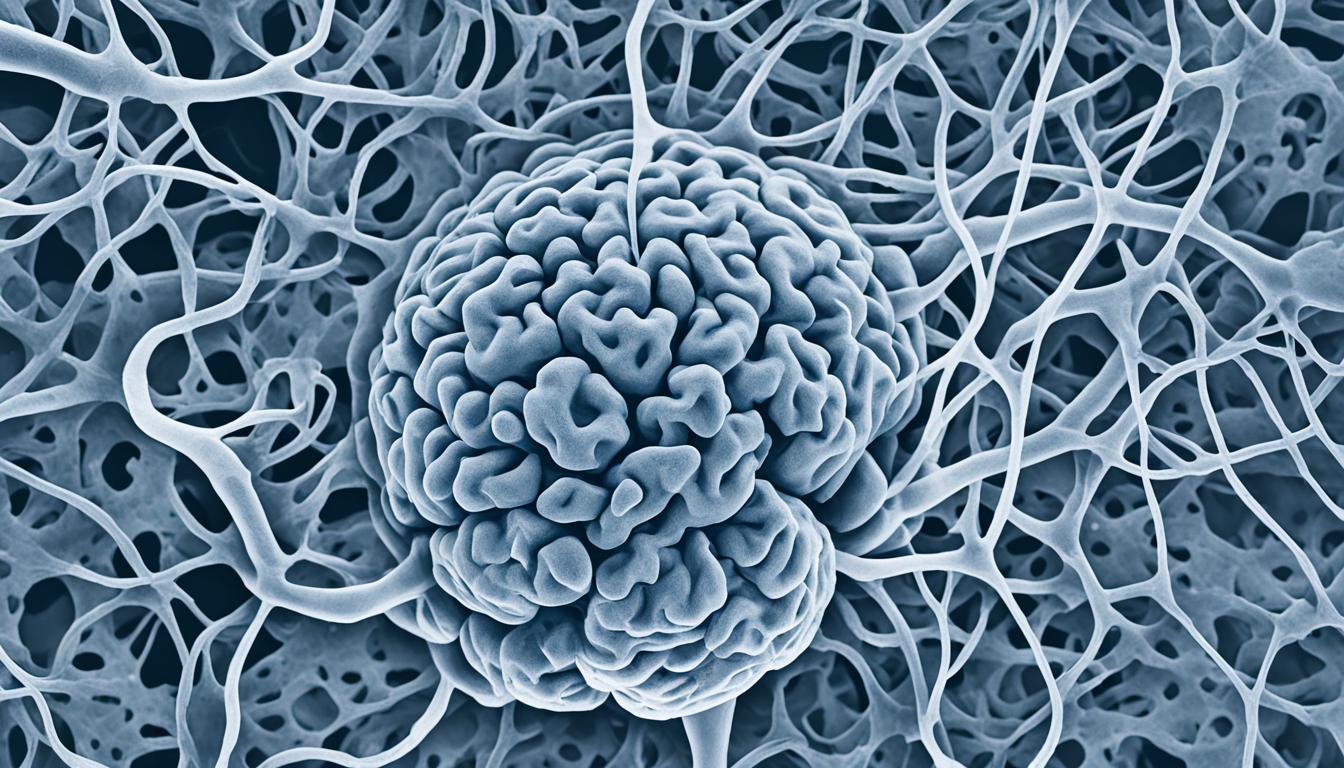Glioblastoma (GBM) is a very aggressive type of brain cancer. It is the most common malignant brain tumor in adults. It makes up about 16% of all brain and central nervous system tumors. Although it usually starts at age 64, it can happen at any age. It’s seen a bit more in men than in women.
Two types of GBMs exist: primary and secondary. Primary GBMs have genetic changes like too much epidermal growth factor receptor (EGFR). They also have PTEN mutations and loss of chromosome 10q. Secondary GBMs, however, often have IDH1 mutations, p53 mutations, and lose chromosome 19q.
People with GBM might have symptoms like headaches, trouble moving, seizures, and more pressure inside their head. Doctors use imaging tests like CT or MRI to diagnose this cancer. Once diagnosed, the main treatments are surgery, radiation, and the drug temozolomide (TMZ). They’re also looking into new treatments like using electric fields to disrupt tumor growth (TTFields) and immunotherapy.
Key Takeaways:
- Glioblastoma (GBM) is a malignant brain tumor that accounts for 16% of all primary brain and central nervous system neoplasms.
- GBMs can be classified as primary or secondary, each exhibiting distinct genetic alterations.
- Common symptoms of glioblastoma include headaches, neurological deficits, seizures, and increased intracranial pressure.
- Diagnosis involves imaging techniques such as CT or MRI scans.
- Treatment options include surgical resection, radiation therapy, chemotherapy with temozolomide (TMZ), and innovative therapies like tumor-treating fields (TTFields) and immunotherapy.
Types of Glioma and their Symptoms
Gliomas are brain tumors that start from glial cells. There are four main types: astrocytoma, ependymoma, glioblastoma, and oligodendroglioma. Each type has its own characteristics and symptoms. This helps doctors tell them apart.
Gliomas can cause various neurological symptoms. These include:
- Persistent headaches: Headaches that don’t go away with usual medicine might point to a glioma.
- Nausea and vomiting: These can happen if the glioma presses on the brain or causes swelling.
- Confusion or decline in brain function: They can make thinking hard, leading to confusion and memory problems.
- Personality changes or irritability: Gliomas can change how a person acts, causing mood swings or irritability.
- Vision problems: They can harm vision, causing trouble seeing or even vision loss.
- Speech difficulties: A glioma in specific areas can make it hard to speak, leading to slurred speech or trouble finding words.
- Seizures: They can make someone have seizures, shown as convulsions, fainting, or odd movements.
The signs someone shows depend on the glioma’s location, type, size, and how fast it grows. It’s key to diagnose the glioma correctly to plan the best treatment.
Diagnosis and Treatment of Glioblastoma
Glioblastoma is diagnosed using computed tomography (CT) and magnetic resonance imaging (MRI). These tests locate and show the tumor’s details. Sometimes, a biopsy is done to check the tissue closely.
Treating glioblastoma needs many types of treatment. Surgery tries to remove the tumor without hurting the healthy area. After surgery, radiation therapy and chemotherapy with temozolomide (TMZ) fight leftover cancer cells.
Doctors also use tumor-treating fields (TTFields) to stop cancer growth with electric fields. They and researchers are looking into new ways to treat glioblastoma.
Innovative Therapies for Glioblastoma
Medical experts are always looking for new treatments for glioblastoma. They’re testing exciting methods in addition to the usual treatments:
- Immunotherapy: This uses the immune system to fight cancer. New drugs and therapies that help the body’s defense are in trials for glioblastoma.
- Tumor-Treating Fields: TTFields are electric fields from a device called Optune. It can be helpful alongside regular treatments.
Clinical trials are key for finding better ways to treat glioblastoma. They test if new treatments are safe and if they work well for patients.
| Treatment | Description |
|---|---|
| Surgery | Removal of as much tumor as possible without damaging surrounding healthy tissue. |
| Radiation Therapy | Use of high-energy X-rays or proton beams to kill remaining tumor cells after surgery. |
| Chemotherapy (temozolomide) | Administration of drugs to target and destroy cancer cells. |
| Tumor-Treating Fields (TTFields) | Application of alternating electric fields to inhibit cancer cell growth. |
| Immunotherapy | Use of drugs and treatments to boost the body’s immune response against cancer cells. |
Getting advice from top neuro-oncologists and neurosurgeons is crucial for those with glioblastoma. They can help figure out the best treatment plan.
Conclusion
Glioblastoma is a tough brain tumor with low survival chances. Current treatments like surgery, radiation, and chemo often don’t cure it. Many patients see the disease come back.
But there’s light at the end of the tunnel. New treatments like TTFields and immunotherapy could boost survival for glioblastoma patients. TTFields are electrical fields that stop cancer from growing. Immunotherapy uses your immune system to attack and kill tumor cells.
Clinical trials are testing these and other new treatments. The goal is to find ways to help patients and their families. If you or someone you know has glioblastoma, getting top care right away is key for a better outcome.

